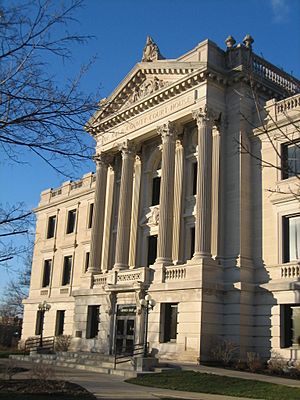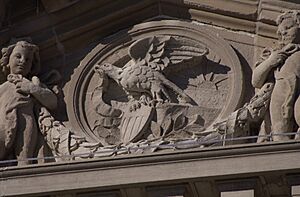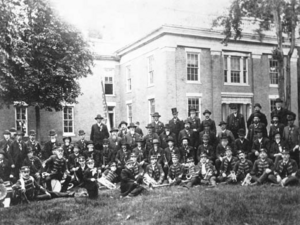DeKalb County Courthouse (Illinois) facts for kids
Quick facts for kids |
|
|
DeKalb County Courthouse
|
|
|
U.S. Historic district
Contributing property |
|

Eastern side
|
|
| Location | Sycamore, DeKalb County, Illinois, U.S. |
|---|---|
| Built | 1905 |
| Architect | Herbert T. Hazelton (Watson & Hazelton) |
| Architectural style | Nlassical |
| Part of | Sycamore Historic District (ID78003104) |
| Added to NRHP | May 2, 1978 |
The DeKalb County Courthouse is an important building in Sycamore, Illinois, which is the main city of DeKalb County, Illinois. This beautiful building looks like a classical Greek or Roman temple. It was built in 1905, but there was a big debate about where it should be located. This building is actually the third courthouse for DeKalb County.
Today, the DeKalb County Courthouse is still the main place for trials and legal matters in the county. It's also a special part of the Sycamore Historic District, which was added to the National Register of Historic Places in 1978. Over the past 100 years, many important court cases have happened here.
The courthouse is built in the Classical Revival style. You can see this in its stained glass windows, tall columns, and a triangular section called a pediment. The back of the building looks like a temple and also has stained glass. A covered driveway, called a porte-cochere, is at the back. Inside, on the third floor, the courtroom has a cool stained glass skylight. In the early 1980s, a TV movie even filmed some scenes in this courtroom!
Contents
History of the DeKalb County Courthouse
The DeKalb County Courthouse we see today is the third building to serve as the county's main court. The first one was a log cabin built in 1839, right across the street from where the current courthouse stands. Ten years later, in 1850, the second courthouse was built. The current building, finished in 1905, stands on the same spot as the 1850 one.
The First Courthouse
The first DeKalb County court started in June 1839 in Sycamore's first courthouse. At first, it wasn't clear if Sycamore would be the permanent home for the courthouse. Other towns, like Brush Point and Coltonville, also wanted to be the "county seat" (the main town for county government).
One county official tried to make Coltonville the county seat by secretly holding an election. But the DeKalb County court stepped in. They got the Illinois General Assembly (the state's law-making group) to make sure the courthouse would be built in Sycamore. After this, Coltonville and Brush Point eventually disappeared from the map. This settled the big question of where the county seat would be.
The Second Courthouse
By 1849, DeKalb County was growing, and a new courthouse was needed. County leaders chose three citizens to plan a new building. They decided it should be made of brick, about 60 feet by 40 feet, and cost no more than $6,000. Private citizens helped by donating a quarter of the cost.
The old log courthouse was sold to help pay for the new one. William Phelps was hired to build the new two-story brick building. It had a large cupola (a small dome-like structure) with a clock tower. The building was finished in 1850, and the county celebrated with a big party in 1851.
The Third and Current Courthouse

The third and current DeKalb County Courthouse was built in 1905. It cost about $137,000. This project brought back the old debate about where the county seat should be. In 1901, the county leaders approved $100,000 for a new building. They even looked at the courthouse in Lee County, Illinois as a model. While similar, the DeKalb courthouse is a bit different; the Lee County building has a dome on its roof. By 1903, the budget increased to $140,000, and the fight over the county seat began again.
This time, the city of DeKalb wanted the courthouse. Two important citizens from DeKalb offered to donate $20,000 each if the courthouse moved there. Sycamore responded by raising $70,000 from its own citizens. The legal arguments went on until 1904. Even though one DeKalb citizen later offered $103,000, it was decided that the county seat would stay in Sycamore. Construction began on October 29, 1903, even with the ongoing legal battles. The building was finished on March 1, 1905. The old 1850 courthouse was then taken down.
In more recent times, the third DeKalb County Courthouse has been featured in movies. In 1982, a TV movie called "Will" filmed scenes in the third-floor courtroom. The courthouse also serves as the main place for all trials and court meetings in DeKalb County.
Circuit Court History
The DeKalb County Courthouse is the main place for legal proceedings in DeKalb County. It is part of the Illinois 16th Judicial Circuit, which also includes courts in Kendall and Kane Counties. Over its long history, many interesting events have happened at the courthouse.
For example, in 1971, some Northern Illinois University students were arrested for protesting. They were blocking roads to protect a forested area on campus. About 150 students were involved, and twelve were arrested. Their court cases at the DeKalb County Courthouse were even covered by a big newspaper, the Chicago Tribune. All charges against the students were eventually dropped.
In 1990, a judge named Rex Meilinger was retiring. He asked if his retirement dinner could be held at the courthouse. The county board agreed! Tables were set up in the lobbies on every floor, and the first-floor office was turned into a temporary drink station. After dinner, a fun "roast" (where people tell funny stories about someone) was held in the third-floor courtroom to honor the judge.
Courthouse Architecture
Exterior Design
The courthouse faces south towards Illinois Route 64. It was designed by architect Herbert T. Hazelton. The building is about 128 feet long and 100 feet wide, with three stories. Its outside is covered in limestone from Bedford, Indiana. Because it sits in the public square in downtown Sycamore, it looks very grand from all directions.
Above the main doors, you can see heavily carved stone supports called brackets. Four tall columns stand out on the front, reaching up two stories. These columns combine Ionic and Corinthian styles. Stone railings, called balustrades, decorate a small balcony on the second floor. The windows on the second floor also have rows of balustrades below them, which go all the way around the building.

A classical sculpture is on the triangular pediment above the front columns. The seal of the State of Illinois is the most important part of this sculpture. The windows on the third floor have beautiful stained glass at the top. The roof's edge has three rows of balustrades and stone blocks. You can also spot an anthemion (a flower-like decoration) at the very top of the pediment, which is common in classical buildings. The roof itself is surrounded by stonework and balustrades.
The north side of the courthouse is not as fancy as the south side, but it has its own special features. A stone porte-cochere (a covered entrance for vehicles) is at the back. This side of the building also has four pilasters (flat columns attached to the wall) that make it look like a temple.
Interior Design
From 1984 to 1987, the inside of the DeKalb County Courthouse was restored. This work cost about $100,000 and was finished just in time for DeKalb County's 150th birthday celebration. The modern front doors actually hide the original, heavy beveled glass doors, which are now kept open for people to admire.
Inside the main lobby, there's a large marble staircase leading to the second floor. The staircase and the lower part of the walls (called wainscoting) are made of gray marble from Tennessee. Most of the first floor is original, including the hexagonal marble floor, stained glass windows, and two original courtrooms. The plasterwork on the walls and ceilings in the lobby is very fancy.
As you go up the stairs, you'll see bronze railings with mahogany banisters. The railings have a swastika symbol, which is a very old design found in many cultures around the world, long before it was used by Nazi Germany. At the bottom of the stairs, and on the landing between the second and third floors, there are bronze ram's heads on the newel posts (the main posts at the end of a staircase).
The second-floor landing offers a great view of the original stained glass windows, which were fully restored in the 1980s. An elevator was added in the 1950s for easier access. Originally, there were two staircases from the second to the third floor, but one was removed when the elevator was installed.
The third-floor courtroom is very grand. It has a stained glass skylight in the center with a ten-pointed star design. The room is lit by six brass lamps and chandeliers with glass globes. When it was first built, an old-fashioned four-bladed ceiling fan hung from the ceiling. Many people consider this courtroom to be the most unique space inside the building. All the furniture, chandeliers, plasterwork, beveled glass doors, and stained glass in this room are original.
Significance of the Courthouse
The DeKalb County Courthouse was included in the Sycamore Historic District when it was nominated for the National Register of Historic Places in 1978. Out of 209 buildings in the district, the courthouse is one of 40 that are considered to have "special architectural and/or historical significance." This means it plays a big role in showing the unique character of the historic district. The courthouse was specifically mentioned in the 1978 nomination for its "architectural significance."
Images for kids
-
The third and current courthouse is possibly the jewel of the Sycamore Historic District.
-
The columns that decorate its front facade of the courthouse combine Ionic and Corinthian themes.
See also
 In Spanish: Palacio de Justicia del Condado de DeKalb (Illinois) para niños
In Spanish: Palacio de Justicia del Condado de DeKalb (Illinois) para niños









